Choosing between Cambodian hair vs Vietnamese hair is all about finding the perfect match for your style, as both are celebrated for their beauty and durability while possessing unique charm. If you’re wondering “Cambodian hair vs Vietnamese hair which is better?”, understanding their differences will help you make the best choice for stunning, long-lasting hair.
What Vietnamese and Cambodian hair Have in Common
Situated in the same Southeast Asian region, Vietnam and Cambodia share cultural and environmental similarities that extend to the characteristics of their hair. While differences exist in texture and structure, both types are highly valued in the hair extension industry for their quality and versatility.
Hair from both Vietnam and Cambodia naturally comes in deep black or a blend of black and brown, making it easy to blend with various hair types and an ideal base for customization. This rich, natural tone enhances its appeal for those looking to dye or style their extensions.
Whether sourced from Vietnam or Cambodia, the hair responds well to various styling techniques. It can be dyed, bleached, and heat-styled without significant damage, making it a preferred choice for those who love to experiment with different looks. The durability and adaptability of both hair types ensure that users can achieve a wide range of styles while maintaining a natural and healthy appearance.
These commonalities largely stem from the similar climates of both countries. The tropical weather, high humidity, and traditional hair care methods contribute to the strength, resilience, and lasting softness of the hair, ensuring it remains lustrous even after processing.

The Roots of Cambodian and Vietnamese Hair
The Origins of Cambodian hair
Cambodian hair predominantly originates from the Khmer people, who constitute the vast majority of Cambodia’s population. This hair is frequently harvested from individuals living in the rural regions of Western Cambodia, where economic hardship is prevalent. For many women in these communities, selling their hair serves as a crucial source of income, providing essential support for their families. This practice allows them to meet daily living expenses and alleviate financial strain.
Women in these areas rarely style their hair with chemical treatments or excessive heat before selling it to manufacturers. This minimal processing contributes to the hair’s inherent softness and silky texture, qualities highly valued by consumers. It is important to acknowledge that although the Khmer people are the majority, the number of individuals that sell their hair is a very small portion of the total population.
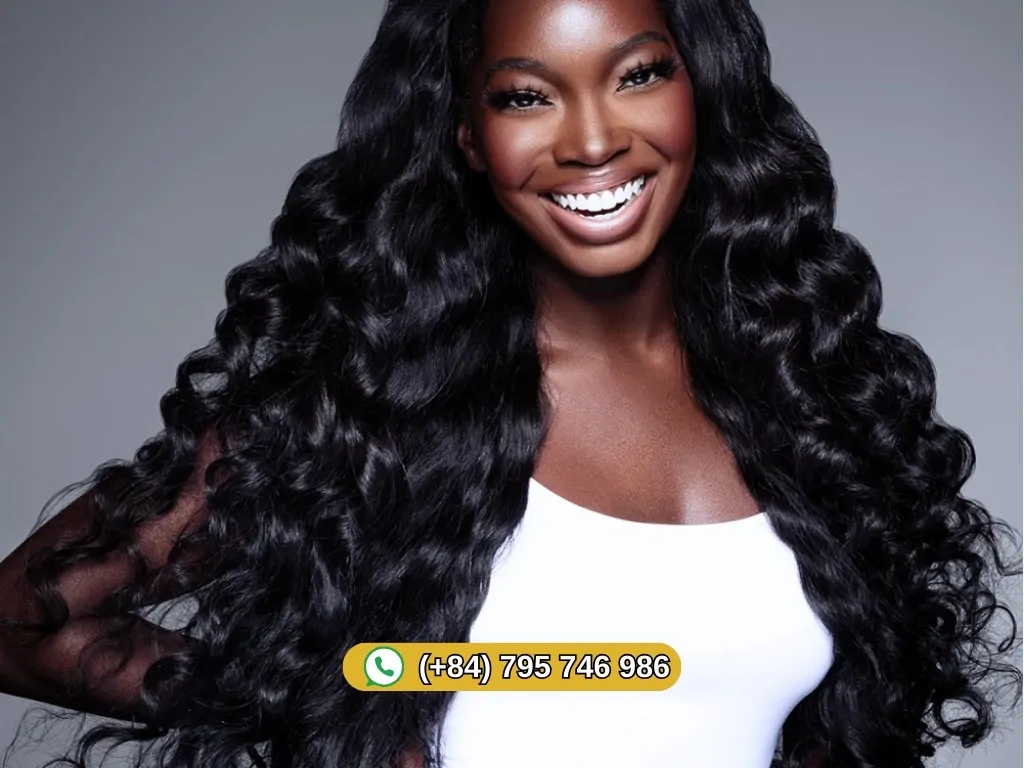
The Origins of Vietnamese Hair
In contrast, hair sourced from Vietnam benefits from a larger potential donor pool due to the country’s population exceeding 90 million. Much of this hair comes from ethnic minority communities residing in the northern highlands of Vietnam. These communities have a rich tradition of cultivating long, healthy hair using solely natural products and avoiding chemical treatments. This practice results in hair that is naturally smooth and shiny. Vietnamese hair is categorized into two main types: Remy and virgin. Remy hair, collected from multiple donors, undergoes careful selection to ensure consistency in quality and appearance. Virgin hair, sourced from a single donor, is considered the pinnacle of quality.
Following collection, Vietnamese hair undergoes meticulous cleaning and processing by manufacturers before being presented to the market. This processing ensures that the hair meets high standards and is ready for use in extensions. The large population, traditional hair care practices, and careful manufacturing processes have contributed to the widespread popularity of Vietnamese hair in the current hair extension market.
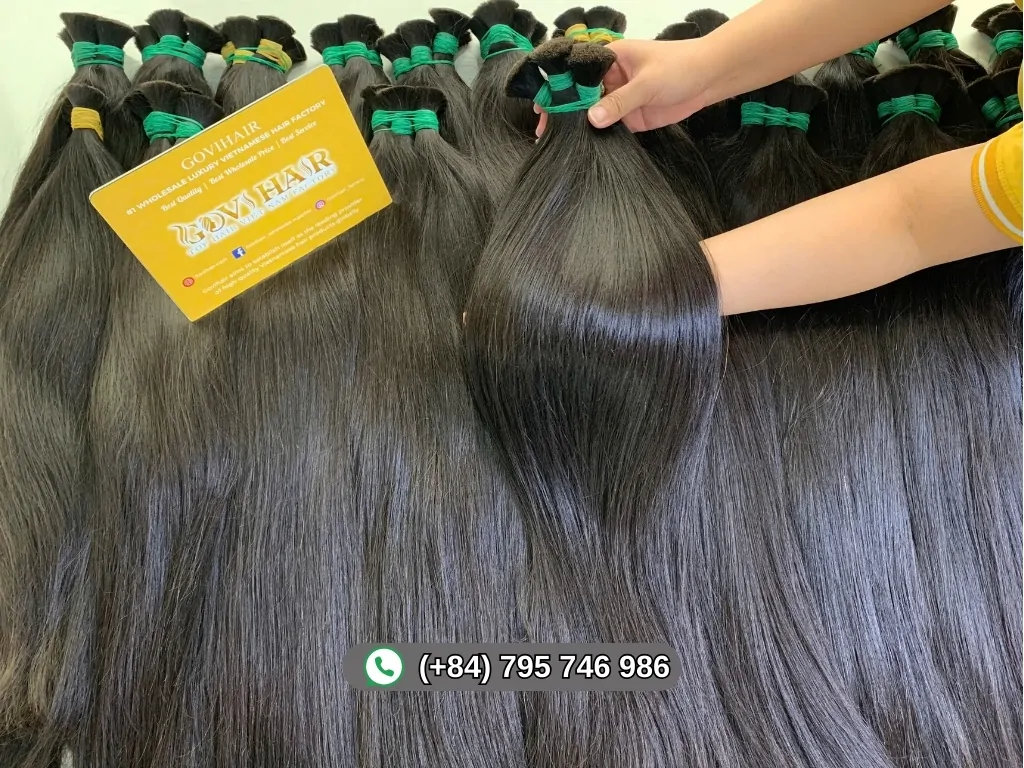
Cambodian vs Vietnamese Hair: What Makes Each Stand Out?
Texture and Density
Cambodian hair is often characterized by a robust, slightly coarse texture. This thicker strand contributes to a fuller, more voluminous appearance, making it a favored choice for those desiring a bold and substantial look. The hair’s inherent density, coupled with its natural wave or slight curl, adds textural richness. For those seeking a sleek, polished look, Cambodian bone straight hair provides a striking contrast to the natural texture, offering a smooth, luxurious finish. Cambodian curly hair, in particular, is prized for its durability and natural wave patterns, making it a top choice among consumers.
Vietnamese hair is renowned for its silky smoothness. The thinner, less coarse hair fibers result in a luxurious, sleek feel. The naturally straight texture minimizes tangling and enhances the hair’s overall manageability. The difference in texture is often attributed to the climate and environmental influences of each country. The drier seasons in Cambodia often result in a thicker, coarser strand.
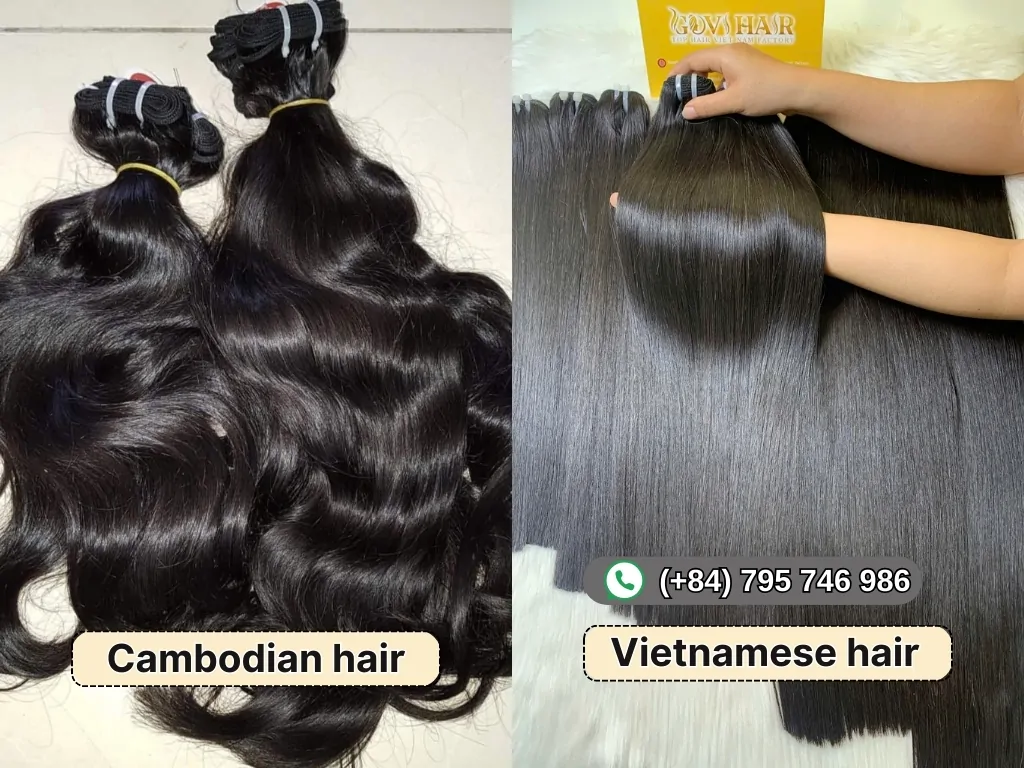
Hair Quality: Durability and Shine Compared
Hair quality, encompassing durability and shine, is a crucial consideration for any hair extension purchase. Cambodian hair, when sourced ethically and unprocessed, maintains its natural cuticle alignment. This contributes to its strength and resilience, although its coarser texture may require more intensive moisturizing and conditioning to maintain its smooth appearance. The natural shine of Cambodian hair is often subtle, reflecting its raw, unprocessed state.
Vietnamese hair, on the other hand, is celebrated for its exceptional shine and inherent strength. The smooth cuticle and healthy hair fibers contribute to a lustrous appearance, even after styling treatments. The traditional hair care practices employed by Vietnamese women, utilizing natural herbal components, contribute to the hair’s overall health and vitality. This leads to a longer life span, and a natural shine that is hard to replicate. When considering durability, Vietnamese hair often outlasts Cambodian hair, due to the processing and general health of the strands.

The Best Value for Your Money: Cambodian vs Vietnamese Hair
Donors of Cambodian hair typically receive between $15 and $25, a modest amount compared to its high resale value. Retail prices for Cambodian hair begin around $30 for a raw hair bundle and $50 for a 16-inch weft, with resale prices soaring to $100 to $300 for the same items. This elevated cost stems primarily from the limited supply of raw Cambodian hair, creating a scarcity that drives up prices.
Conversely, hair originating from Vietnam presents a more accessible and reasonable pricing structure. A 100g hair bulk can be acquired for as little as $8, while a 16-inch weft costs approximately $33. This difference in price is largely attributed to the more abundant supply of Vietnamese hair, a result of the country’s larger population and established hair industry. Furthermore, many Vietnamese suppliers operate as direct factories, eliminating middlemen and reducing costs.
When comparing Cambodian hair vs Vietnamese hair price, it’s clear that Vietnamese hair is the more budget-friendly option while still maintaining high quality. The ability to purchase high-quality Vietnamese hair at a lower price point, coupled with its consistent quality and longevity, positions it as a superior value proposition. The broader availability of Vietnamese hair also allows for greater flexibility in purchasing options.
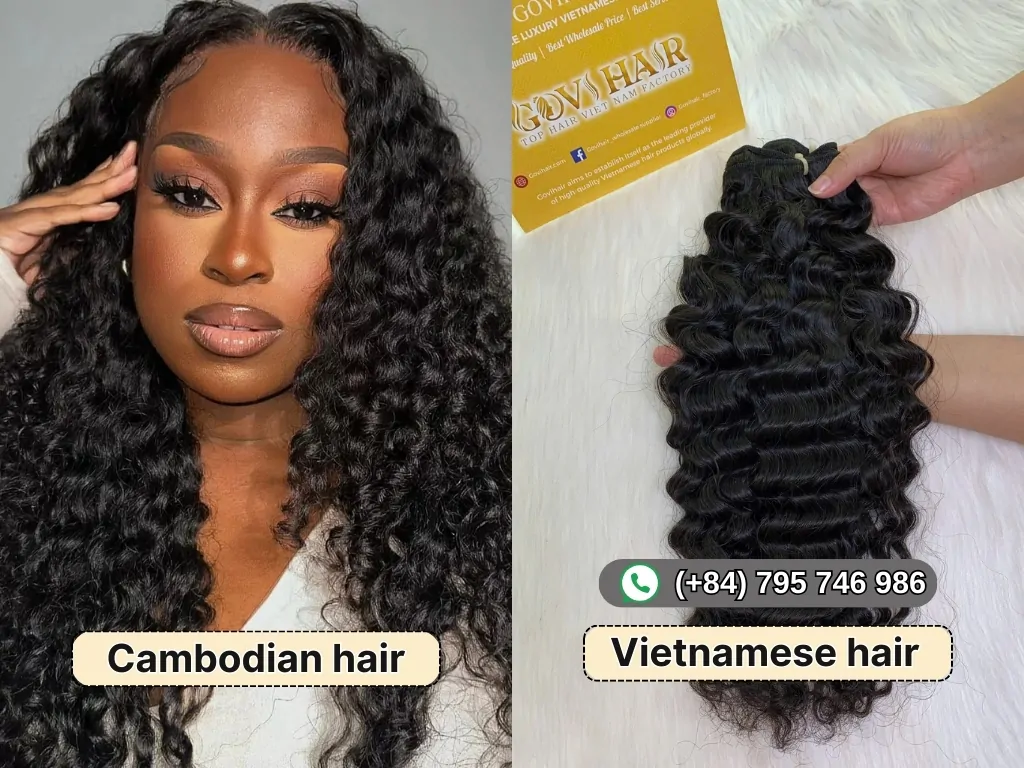
Production Scale of Cambodian vs Vietnamese Hair
The Cambodian hair industry is characterized by its relatively small-scale operations. Factories are primarily domestic enterprises, often household workshops or collector stores, with an estimated 30-40 factories in operation. These are typically family-run businesses, employing around 30-40 workers and relying heavily on traditional processing techniques. The technology and machinery used are rudimentary, hindering production efficiency and product quality. Furthermore, the limited supply of raw hair in Cambodia makes it difficult for these factories to fulfill large orders in a timely manner, and stock availability is often limited. This small-scale production means that Cambodian hair, often sourced through a Raw Cambodian hair vendor, is available in smaller quantities, and with less processing options.
In contrast, hair originating from Vietnam benefits from a larger and more developed production scale. While Vietnamese hair factories also predominantly operate on a small to medium scale, similar to household workshops, they benefit from a more abundant supply of raw materials. Vietnam boasts approximately a hundred hair factories, alongside trading enterprises and specialized craft villages. These factories employ a larger workforce, typically ranging from 80-150 workers, and benefit from a skilled labor force with a long history in the hair industry. Although the technology and machinery may not be the most advanced, Vietnamese manufacturers are actively investing in improving their facilities and increasing production efficiency.
Cambodian hair vs Vietnamese Hair: The Best Choice for Your Style
When seeking the perfect hair extensions, the choice between Cambodian and Vietnamese hair presents a significant decision. While both options offer natural human hair, their distinct characteristics, availability, and pricing structures make one a more advantageous selection for many. The following table summarizes the key Cambodian hair vs Vietnamese hair pros and cons:
| Cambodian hair | Vietnamese Hair | |
| Supply | Shortage | Abundant |
| Production Scale | Domestic size, mini workshop | Both large factories & household workshops |
| Production Time | Longer due to lack of raw materials | 5-10 days |
| Hair Features | Thick, soft wavy, lightly ruffled, coarse | Smooth, strong, shiny, soft, silky |
| Hair Style | Suitable for wavy & curly styles | Suitable for all styles |
| Price | Competitive, but higher than Vietnamese hair | Reasonable |
| Durability | 10-12 months | 20-24 months |
| Texture | Coarse | Smooth |
| Availability | Mostly available in raw form, lack of diversity | Available in various textures, styles and large quantities |
| Origin | Taken from Cambodian women, corpses, smuggling | Collected from Vietnamese women |
For those seeking a reliable source of high-quality, versatile, and affordable hair extensions, Vietnamese hair stands as the optimal choice. Its ability to cater to diverse styling needs and ensure a long-lasting, beautiful look makes it a smart investment for anyone looking to enhance Vietnamese hair style.
The Best Sources for Premium Vietnamese Hair
When seeking the highest quality hair extensions, particularly those originating from Vietnam, discerning buyers understand the importance of sourcing from reputable suppliers. Vietnamese hair, renowned for its silky texture, durability, and natural beauty, has become a coveted commodity in the global hair market. Among the leading names in the Vietnamese hair factory industry, Govihair stands out as exceptional sources.
Govihair: Excellence in Vietnamese Hair Quality and Sourcing
Govihair has established itself as a trusted provider of premium Vietnamese hair, known for its commitment to quality and ethical sourcing. They prioritize the collection of hair from healthy donors, ensuring that the hair maintains its natural luster and strength. Our meticulous processing methods preserve the hair’s cuticle alignment, resulting in extensions that are tangle-free and long-lasting. Govihair offers a diverse range of hair textures and styles, catering to various preferences and needs. Our dedication to customer satisfaction and transparent business practices has earned them a strong reputation in the industry.
As someone who works directly with international buyers every day, I often get asked: ‘What’s the difference between Cambodian hair and Vietnamese hair?’ Both are popular in the human hair industry, but they have very different textures, sources, and use cases.
Cambodian hair is known for being coarse, thick, and slightly wavy or curly. It feels fuller and blends well with Afro-textured or medium-coarse hair types. That’s why it’s often preferred in African markets or by customers who want volume and bounce.
On the other hand, Vietnamese hair is naturally straight, silky, and soft. It’s usually collected from single donors in the rural north of Vietnam, where women take care of their hair with herbal treatments. It’s cuticle-aligned, strong, and perfect for bleaching, dyeing, or long-term styling.
At Govihair, we recommend:
- Cambodian hair for curly wig lines, textured installs, or clients needing thick, voluminous styles
- Vietnamese hair for premium straight bundles, natural-looking wigs, and clients who want to restyle, color, or customize their hair
Both are great—but it depends on your customer’s preference. The key is knowing your market and choosing the hair that matches it best.
How to buy hair from Vietnam? For inquiries and orders, feel free to reach out to Govihair through the following channels:
- WhatsApp: (+84) 795 746 986
- Email: [email protected]
- Website: govihair.com
- Instagram: govihair_factory
- Facebook: Govihair – Wholesale Hair Extensions

Conclusion
The choice between Cambodian hair vs Vietnamese Hair depends on your individual preferences and needs. Prioritize quality, ethical sourcing, and proper care to ensure a satisfying and long-lasting experience.Cambodian and Vietnamese hair are the best hair extensions for very short hair. The best choice for you will depend on your budget and your personal preferences. If you are looking for affordable, high-quality extensions, Cambodian hair may be a good option. If you are willing to invest in premium-quality hair, Vietnam hair may be the better choice. While both are great choices, they have notable differences that make them suitable for different hair types and styling needs.





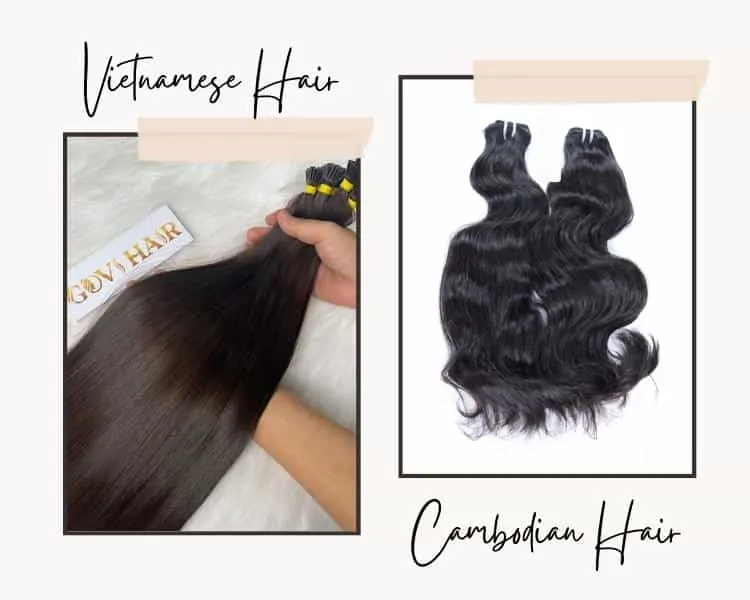




 Ms. Jade
Ms. Jade